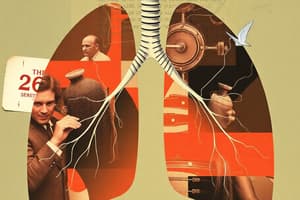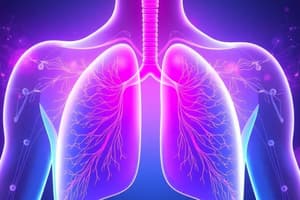Podcast
Questions and Answers
During inhalation, what changes occur in the thoracic cavity and lungs?
During inhalation, what changes occur in the thoracic cavity and lungs?
- The diaphragm relaxes, decreasing the volume of the thoracic cavity while the lungs expand.
- The diaphragm and external intercostal muscles relax, decreasing the volume of the thoracic cavity and contracting the lungs.
- The diaphragm and external intercostal muscles contract, increasing the volume of the thoracic cavity and expanding the lungs. (correct)
- The diaphragm contracts, decreasing the volume of the thoracic cavity, causing the lungs to contract.
How does the pressure within the lungs change during inhalation, and what effect does this have?
How does the pressure within the lungs change during inhalation, and what effect does this have?
- The pressure remains constant, maintaining equilibrium with the external environment.
- The pressure fluctuates randomly, aiding in efficient gas exchange.
- The pressure increases, causing air to be expelled from the lungs.
- The pressure decreases, creating a pressure gradient that draws air into the lungs. (correct)
What is the sequence of events during exhalation?
What is the sequence of events during exhalation?
- Diaphragm and intercostal muscles contract, thoracic cavity volume increases, lung pressure decreases, air enters lungs.
- Diaphragm and intercostal muscles contract, thoracic cavity volume decreases, lung pressure increases, air enters lungs.
- Diaphragm and intercostal muscles relax, thoracic cavity volume decreases, lung pressure increases, air exits lungs. (correct)
- Diaphragm and intercostal muscles relax, thoracic cavity volume increases, lung pressure decreases, air exits lungs.
A person's tidal volume is measured as 500 mL. What does this measurement represent?
A person's tidal volume is measured as 500 mL. What does this measurement represent?
What is the significance of residual volume in the lungs?
What is the significance of residual volume in the lungs?
A patient has a vital capacity of 4.0 liters and a residual volume of 1.5 liters. What is their total lung capacity?
A patient has a vital capacity of 4.0 liters and a residual volume of 1.5 liters. What is their total lung capacity?
How does the composition of exhaled air differ from that of inhaled air?
How does the composition of exhaled air differ from that of inhaled air?
Why does the body require a higher rate of cellular respiration during exercise?
Why does the body require a higher rate of cellular respiration during exercise?
Increased breathing rate during exercise helps supply oxygen for what process?
Increased breathing rate during exercise helps supply oxygen for what process?
Which of the following is a viral infection affecting the upper respiratory tract?
Which of the following is a viral infection affecting the upper respiratory tract?
What is the primary characteristic of pneumonia regarding its effect on the alveoli?
What is the primary characteristic of pneumonia regarding its effect on the alveoli?
Which of the following occurs in the airways of a person experiencing an asthma attack?
Which of the following occurs in the airways of a person experiencing an asthma attack?
What characterises emphysema at the alveolar level?
What characterises emphysema at the alveolar level?
Which of the following is a key characteristic of chronic bronchitis?
Which of the following is a key characteristic of chronic bronchitis?
A patient is diagnosed with COPD. Which two conditions are most likely contributing to this diagnosis?
A patient is diagnosed with COPD. Which two conditions are most likely contributing to this diagnosis?
How does long-term cigarette smoking primarily contribute to lung damage?
How does long-term cigarette smoking primarily contribute to lung damage?
What is the impact of smoking on the cilia in the respiratory tract?
What is the impact of smoking on the cilia in the respiratory tract?
How does the destruction of cilia in the respiratory tract contribute to the development of lung cancer?
How does the destruction of cilia in the respiratory tract contribute to the development of lung cancer?
Which of the following is a direct consequence of the accumulation of carcinogenic material in the respiratory tract?
Which of the following is a direct consequence of the accumulation of carcinogenic material in the respiratory tract?
In chronic bronchitis, what functional problem in the lungs directly results from the increased mucus secretion and damage to cilia?
In chronic bronchitis, what functional problem in the lungs directly results from the increased mucus secretion and damage to cilia?
Flashcards
Inhalation
Inhalation
Contraction of diaphragm and external intercostals increases thoracic cavity volume and inflates lungs.
Inhalation Pressure
Inhalation Pressure
Increased lung volume during inhalation reduces internal pressure, drawing air in from higher pressure outside.
Exhalation
Exhalation
Relaxation of diaphragm/intercostals reduces thoracic cavity size, increasing lung pressure to expel air.
Tidal Volume Definition
Tidal Volume Definition
Signup and view all the flashcards
Vital Capacity
Vital Capacity
Signup and view all the flashcards
Residual Volume
Residual Volume
Signup and view all the flashcards
Total Lung Capacity
Total Lung Capacity
Signup and view all the flashcards
Exhaled Air Composition
Exhaled Air Composition
Signup and view all the flashcards
Exercise and Respiration
Exercise and Respiration
Signup and view all the flashcards
Common Cold
Common Cold
Signup and view all the flashcards
Pneumonia
Pneumonia
Signup and view all the flashcards
Asthma
Asthma
Signup and view all the flashcards
COPD
COPD
Signup and view all the flashcards
Emphysema
Emphysema
Signup and view all the flashcards
Chronic Bronchitis
Chronic Bronchitis
Signup and view all the flashcards
Smoking and Lung Disease
Smoking and Lung Disease
Signup and view all the flashcards
Smoking and Cilia
Smoking and Cilia
Signup and view all the flashcards
Study Notes
- During inhalation:
- The diaphragm and external intercostal muscles contract.
- This increases the volume of the thoracic cavity.
- The lungs expand.
- Increased lung volume during inhalation lowers lung pressure below atmospheric pressure.
- Air rushes into the lungs down a pressure gradient.
- During exhalation:
- The diaphragm and external intercostal muscles relax.
- The volume of the thoracic cavity decreases.
- The lungs decrease in volume.
- Air pressure inside the lungs increases above atmospheric pressure, pushing air out.
- Tidal volume refers to the volume of air inhaled or exhaled during each breath at rest.
- Vital capacity is the maximum volume of air exhaled after maximum inhalation.
- Even after forceful exhalation, some air remains in the lungs, preventing collapse, known as residual volume.
- Total lung capacity equals vital capacity plus residual volume.
- It's the volume of air filling the lungs after maximum inhalation.
- Exhaled air composition differs from inhaled air.
- Gas exchange in the alveoli results in lower oxygen and higher carbon dioxide levels in exhaled air.
- During exercise or physical activity, higher energy amounts are needed for muscle contraction.
- This energy is supplied through increased cellular respiration.
- An increased rate of cellular respiration requires higher oxygen amounts.
- These are supplied by an increased breathing rate.
Common Respiratory Diseases
- The common cold is a viral infection affecting upper respiratory tract organs.
- Pneumonia can be caused by bacterial or viral infections.
- It mainly affects the alveoli, causing inflammation and fluid accumulation.
- Asthma is characterized by inflammation and narrowing of airways, mainly the bronchi and bronchioles.
- This causes increased muscle contraction, congestion, and reversible airway constriction.
- Chronic Obstructive Pulmonary Disease (COPD) includes emphysema and chronic bronchitis.
- Emphysema involves irreversible enlargement of the alveoli and weakening of alveolar walls.
- The alveoli break, merge, reduce air spaces, and decrease gas exchange surface area.
- Chronic bronchitis is a persistent bronchitis type linked to smoking and air pollution.
- Irritants increase mucus secretion and destroy cilia, which propel mucus away from the lungs.
- COPD and lung cancer are often caused by long-term cigarette smoking.
- Smoking is linked to lung cancer due to carcinogenic material accumulation following cilia destruction.
- Cilia normally remove harmful substances.
Studying That Suits You
Use AI to generate personalized quizzes and flashcards to suit your learning preferences.




